

Exploring our past to sort out myth from reality
Share this Page on
Facebook or Twitter

These are the voyages of the TimeShip Anachron.
Our Mission: To boldly explore the past, dispelling
mythinformation and mythconceptions
of American History along the way.
 Visit us on Facebook
Visit us on Facebook
Meet MythAmerica LITE
On Top of Old Topper
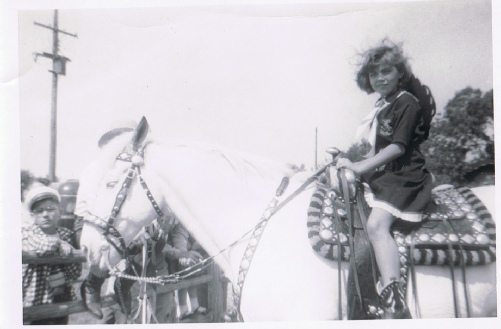
You probably need to be of a “certain age” to actually recognize this famous white stallion. (No, it’s not the Lone Ranger’s “Silver.”) And no matter what age they are, few people on earth would recognize the cowgirl on his back.
The cowgirl is me, at about age 7. The year was about 1954, and the location was likely a grocery store parking lot in Dayton, Ohio. The Hopalong Cassidy show was one of the hottest TV shows of the time, and this trusty steed is Hoppy’s horse, “Topper.” Hoppy himself did a lot of touring to connect with his millions of young fans, but obviously he couldn’t make it to every city. So sometimes he sent out Ambassador Topper to stand in for him.
Author Clarence Mulford created the character of Bill Cassidy in 1904, and featured him in a series of many short stories and twenty-
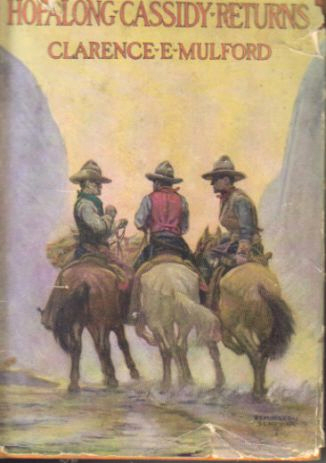
In his early writings, Mulford portrayed the character as rude, dangerous, and rough-
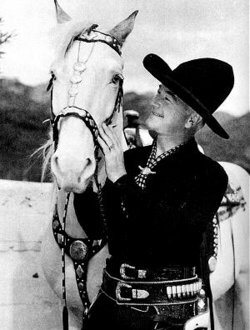
A total of sixty-
As portrayed on the screen, the white-
Hoppy was NOT to be confused with Roy Rogers and Gene Autry, as you can tell by this little dialogue from a 1940 Hoppy movie titled Santa Fe Marshal…
[Doc Tate wants Hoppy to join his medicine show as a guitar-
Doc Rufus Tate: All cowboys nowadays play guitar.
Hopalong Cassidy: Well this is one cowboy that never played a gee-
Boyd had the foresight to recognize the potential of television when it came on the scene. His career in “B-
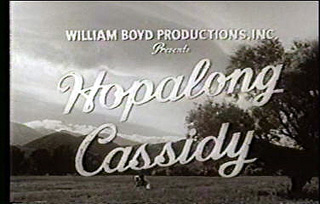
Yet at the same time, he also managed to sell the idea of a radio serial too, and thus he starred in over 100 freshly-
The character of Hoppy, and the TV show, were so popular that Look, Life, and Time magazines featured him on their covers.
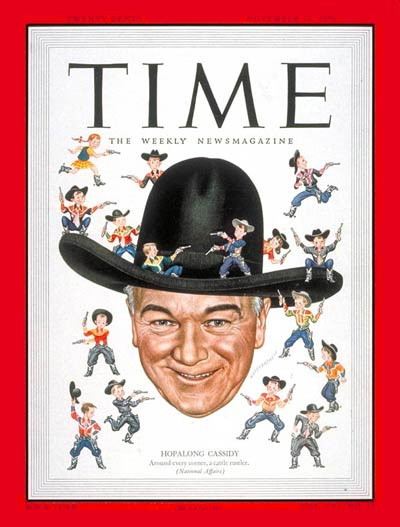
It was such a classic TV show that in 2009 it was featured on a commemorative postage stamp in the “Early TV Memories” series.
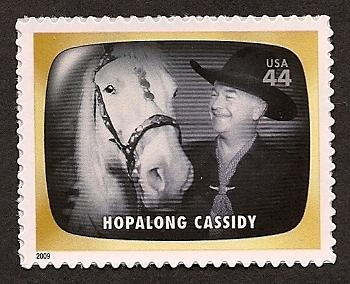
As you might expect, much of Hoppy’s subsequent wealth came not from the shows themselves, but from the “merchandising” connected to the character. In all, Hoppy endorsed more than 2,400 different items, from pajamas to popcorn and pudding.
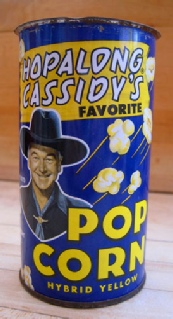
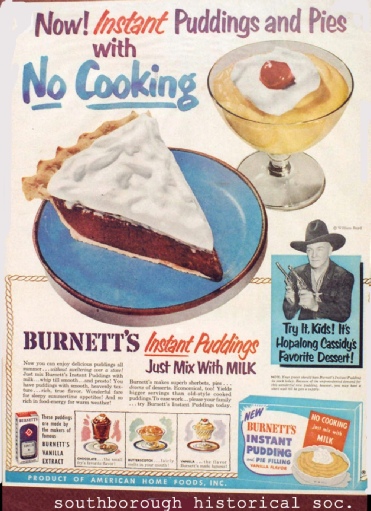
The 1950 lunchbox issued by Aladdin industries was the very first of the TV-
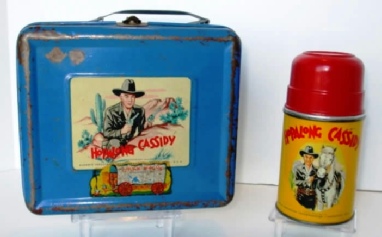
And here’s the even fancier one they issued in 1954, after the process of imprinting more elaborate pictures on the metal had been developed.
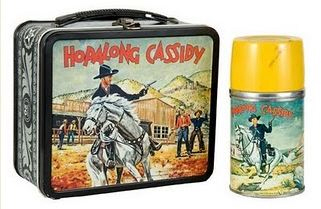
In stores, more than 100 companies in 1950 manufactured $70 million of Hopalong Cassidy products, including children’s dinnerware, pillows, roller skates, soap, wristwatches, and jackknives. [ibid]
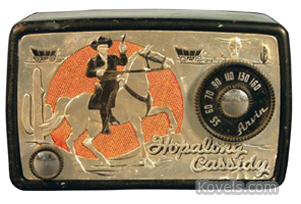
And of course there had to be comic books, starting in 1943.
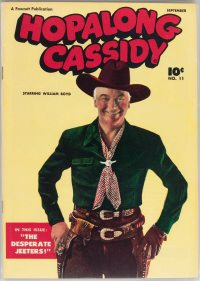
Hoppy was featured in his last issue in 1959.
The TV series spurred a new demand for Hoppy’s old movies to be played in theaters.
Boyd licensed reissue distributor Film Classics to make new film prints and advertising accessories. Another 1950 enterprise saw the home-
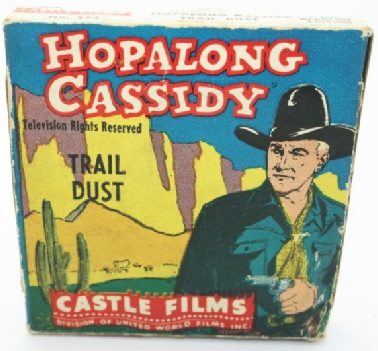
Also, in January 1950 Dan Spiegel began to draw a syndicated comic strip with scripts by Royal Kin Cole; the strip lasted until 1955.

And yes, there was even a theme park!
On May 27, 1951, Hoppyland, opened its doors to hoards of screaming, happy children. It was a theme park devoted to all things Hopalong Cassidy. It was located in Venice California, just 25 miles west of Anaheim -
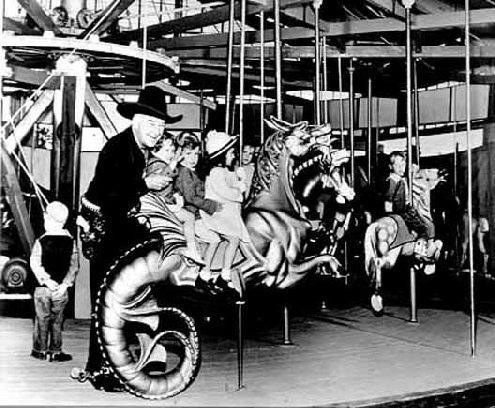
“Bet You Didn’t Know …”
… Cecil B. DeMille reportedly asked Boyd to take the role of Moses in his remake, The Ten Commandments, but Boyd felt his identification with the Cassidy character would make it impossible for audiences to accept him as Moses.
…Two of Hollywood’s greatest names -
…The original American Pie album by Don McLean inner sleeve featured a free verse poem written by McLean about Boyd along with a picture of Boyd in full Hopalong regalia. This sleeve was removed within a year of the album’s release. The words to this poem appear on a plaque at the hospital where Boyd died [in 1972].
…Three other Hollywood notables that at one time rode with Boyd aka Hopalong Cassidy, where George ‘Gabby’ Hayes, Jimmy Rogers -
…Hopalong’s “drink of choice” was the nonalcoholic sarsaparilla.
…Boyd was very loyal to those that contributed to his success. When he retired, he turned over his production company to CBS, who was about to start shooting a new western series called ‘Gunsmoke’, with the stipulation that they continue to employ his entire crew, thus preventing any of his colleagues from being out of work.
Which all brings us back to the subject of the original photo for this entry, Hoppy’s horse.
When Boyd, the actor who portrayed the character of Hopalong Cassidy for approximately 40 years during which he took made 66 feature films and 52 half-
You can visit Topper’s grave at the Los Angeles Pet Memorial Park in California. He’s interred there near the pets of many families, and other celebrity animals such as Rudolph Valentino’s dog Kabar and Pete the Pup, who played “Petey” in the Our Gang (Little Rascals) movies.
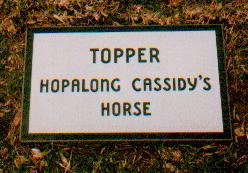
Hoppy, who never even kissed a gal in his movies (except one on the cheek, when she was dying), who didn’t curse or smoke or drink anything harder than sarsaparilla, was definitely one of the Good Guys. Hoppy’s alter ego, actor William Boyd, sincerely appreciated, loved, and cared about all his many child fans, noting, “I’ve tried to make Hoppy a plain and simple man in manners and dress. Hoppy isn’t a flashy character. He isn’t illiterate. Nor is he smart-
Hoppy’s official website: http://www.hopalong.com/home.asp
If you’re nostalgic about Hoppy, or are too young to remember him and wonder what all the fuss was about, check out the movie trailer for his first movie in 1935 (when there was still a hyphen in his name!).
[Some of the material in this article is adapted from information on the Hollywood Cowboy Collectibles website tribute to Hopalong Cassidy.]